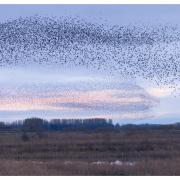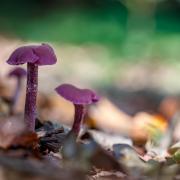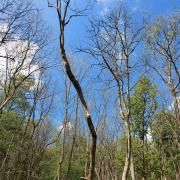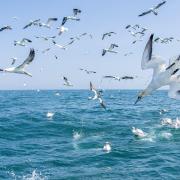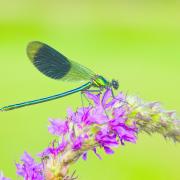Butterflies are one of our most familiar natural delights but Yorkshire is also home to some of the rarest of these miniature winged wonders. Tom Marshall from the Yorkshire Wildlife Trust sets out in search of them.

It’s always good to look your best when meeting the aristocracy. Sadly, as it’s still surprisingly chilly in May in the North York Moors, sartorial custom has taken a back seat in favour of a suitably warm hat and gloves. With any luck though, the sun will soon start to cast its rays on this misty hill on the edge of the National Park and I’ll be ready for my appointment with His Grace.
With such grand nomenclature, you’d be forgiven for thinking the Duke of Burgundy butterfly would be easy to spot in its finery, however nothing could be further from the truth for this most diminutive of butterflies.
My search begins along the crumbling dry stone walls, their lime-green mossy blankets complimented by the crisp icy white of wood anemone and campion, plus the vibrant blue of native English bluebells – always at their best before the harshest sunlight.
Alongside are tangles of brambles and lush early summer bracken – butterfly favourites – and somewhere among the leaves lies the clasped wings of one of our fabled fritillaries, little bigger than a 20 pence piece.
With even the keenest of eyes, this is not an easy subject to track down. ‘The Duke’ keeps excessive flying to a minimum and rarely visits flowers, so the most imperceptible movement could be your only clue. Others, like small whites and perhaps a brimstone, catch your peripheral vision and become a frustrating distraction. Then suddenly, there’s the tiniest of flickers on a bramble leaf and an inch-long pair of wings opens.
Like the hairstreaks and small copper, it seems incredible that something so small and delicate can even survive, but The Duke finally shows off his (or her) finery of chocolate brown and orange wings, with the white tips indicative of the notoriously similar fritillary family. Once considered a definitive fritillary, today it is thought to be the sole member of the ‘metalmark’ family in the UK, a group of butterflies more typically associated with South America.

Notwithstanding its elusive nature, the Duke of Burgundy is also one of our rarest and most threatened butterflies, with Yorkshire one of the last remaining UK strongholds. Thankfully conservation efforts are underway to maintain the careful grassland habitat balance they need, along with the cowslips favoured by their caterpillars.
However, the diminutive Duke of Burgundy is not alone in the finery of the fritillaries, and Yorkshire is holding its own in a tentative renaissance of these sought after butterflies, and thankfully some are rather easier to spot than others.
From one extreme to the other, the dark green fritillary is a positive show-off by comparison, and at around three times the size of The Duke is somewhat less of a challenge. Appearing later in the year, this is a butterfly that enjoys being on the wing and rubbing shoulders with marbled whites, red admirals and peacocks among the high summer meadows. On a warm sunny day, Yorkshire Wildlife Trust’s Brockadale nature reserve near Pontefract or the Vale of Pickering are good places to take a seat and watch.
Thistles and knapweed are particular favourites – perhaps no surprise with the familiar purple hues of plants like buddleia always proving popular with butterflies – and that dark bottle-green becoming apparent when wings are closed.
Another wonderful sounding fritillary is also starting to make Yorkshire its home, in the shape of the silver washed fritillary. This large woodland glade butterfly has been seen in the Yorkshire Dales and the south of the county, and it’s thought it may be on the march north as we experience a warming climate.
Sadly, as we become increasingly delighted with sightings of new butterflies making their way up the country, others remain in trouble. It’s perhaps apt that the beloved but rare pearl also lends its name to two butterflies that are still having a tough time here in Yorkshire, the pearl-bordered and small pearl-bordered fritillary.

Emerging around May and June respectively, the ‘pearls’ have a particular penchant for dog violets, another deep, rich purple flower, with the complex microclimates of sheltered grasslands believed to be key to their caterpillars. While the small pearl-bordered fritillary still retains a scattered distribution across the country from the coast paths of Cornwall to Scottish lochside woodlands, its larger cousin has seen numbers drop by around two thirds between the 1970s and the mid-2000s.
Today, a tiny handful of carefully looked after refuges of the pearl-bordered fritillary are kept under wraps along the North Yorks Moors fringes, while the small pearl can be spotted in the western Dales and Moors too, at sites such as Dalby Forest, Yorkshire Wildlife Trust’s Fen Bog and Jugg Howe and Eller Becks.
Perhaps most astonishing as conservationists battle to secure a future for these butterflies through tireless work to create the right habitats, is a recent case of so-called ‘butterfly collecting’, an activity more typically associated with generations past. In recent weeks a court case has heard that a man from Bristol ignored signs and a locked entrance to allegedly capture large blue butterflies – an extremely rare and globally endangered species. While specimens can be bought from butterfly ‘farms’ on the continent, it remains illegal to capture them in the wild in the UK.
With work well underway to create new sanctuaries for Yorkshire’s rarest butterflies and the hope that others like the silver washed fritillary may soon be making a home here too, the burnt oranges of fritillary wings will no doubt long remain a feature in the county.
And with the Duke of Burgundy flying an – albeit very tiny – flag for this rarest of creatures, surely that’s one wildlife story that deserves to get the royal seal of approval.
What to look out for this month
This month heralds the return of the unrivalled harbinger of summer, the cuckoo. While you’re more likely to hear one first, don’t be fooled by the falcon-like appearance of their wings and long tail as they fly from song post to song post.












